By Dan and Lisa Goy from the November 2017 Edition
February 20-22, 2016 (Days 45-47)
Our drive from Agua Azul to San Cristóbal de las Casas was led by Rafael and Eileen, mostly on Hwy 199, with all the turns and topes, ups and downs, climbing to 7000 feet, over 2000 meters, was nothing short of spectacular! In addition to the amazing vistas, our journey took us through the towns of Ocosingo, Abasolo, San Sebastián, Rancho Nuevo, just prior to joining Hwy 190 and the final leg to San Cristóbal. Unfortunately, we picked up a screw in a rear truck tire however Roland had an air compressor and generator and we had canned sealant that stopped the leak until a more permanent repair could be made.
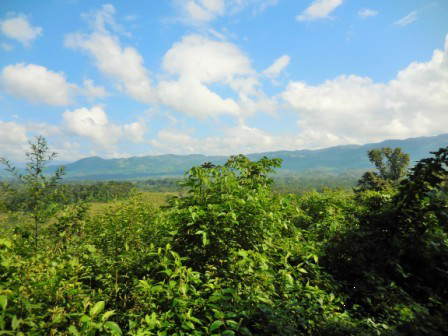
We had phoned ahead and found a Hotel that could accommodate our RVs in their parking lot. The remaining camp-ground in town was too small, with access challenges for our group, hence the need to find an alternative. It was only when
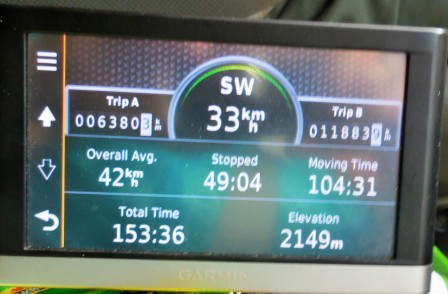
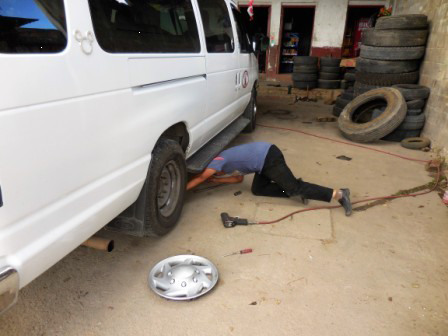
we arrived at the hotel that we realized that the parking arrangements would not work. Luckily the PEMEX gas station 5661 across the street was able to accommodate us at $40 pesos per day, no wifi or showers, just ice cream bars.
After we got set up in the PEMEX, Rafael and I headed off to find a repair shop and the mission was accomplished for $100 pesos. Later, some of us went across the street to a restaurant for dinner. The next day, we made our first foray into San Cristóbal de las Casas Centro and the city lived up to the hype. What a beautiful place! We were able to find parking near the Zócalo for our explorations and headed out to see what the town had to offer. We made our way up to Guadalupe Church on a low rise for a better view of the city. It was a very impres-sive church inside as well. On our walk around, we encountered many indigenous women wearing traditional Tzotzil dress. Good thing we did not bring the RVs into town. The streets are narrow and many closed to traffic.
We did lots of poking around in many shops and purchased more calcomanías (bumper stickers) for the Tango trailer. Later we had lunch with many of the gang on a roof top restaurant on the main square; there was a celebration going on so lots of fireworks were banging above. After lunch, the group met at the van and we headed back to the RVs for a siesta and then at 5:30 pm out for some groceries. Our last day in San Cristóbal was busy and we spent most of our day downtown at the
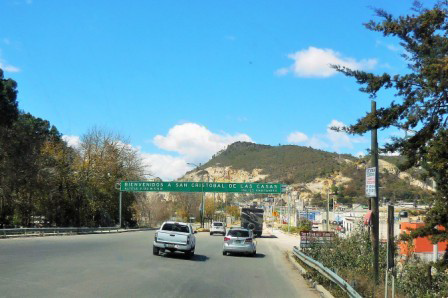
Santo Domingo Dominican Convent at an open air textile market that surrounded the business. This was an unforgettable experience, so many goods, so much colour, so many merchants, just fabulous. After walking the entire outdoor market, we headed off for lunch and found a small taco restaurant where as it happens the gang had also collected for lunch. Inexpensive, tasty and plenty to eat. We met at the 2:00 pm rendez-vous time and headed back to our campground. Later, Mike and I resupplied for agua purificada and Rafael and Eileen found some wifi not too far away. A visit to San Cristóbal de las Casas is a must for any Mexico traveller. We could have spent many more days in this town.
Background
San Cristóbal de las Casas, also known by its native Tzotzil name, Jovel, is located in the Central Highlands region of the Mexican state of Chiapas and was the capital of the state until 1892. San Cristóbal is still considered the cultural centre of Chiapas. This region is mostly made up of mountainous terrain, but the city sits in a small valley surrounded by hills. The city’s center maintains its Spanish colonial layout and much of its architecture, with red tile roofs, cobblestone streets and wrought iron balconies, often with flowers. Most of the city’s economy is based on commerce, services and tourism. Tourism is based on the city’s history, culture and indigenous population, although the tourism itself has affected the city, giving it foreign elements. Major landmarks of the city include the Cathedral, the Santo Domingo church with its large open-air crafts market and the Casa Na Bolom museum. Unfortunately, the municipality has suffered severe deforestation, but it has natural attractions such as caves and rivers.
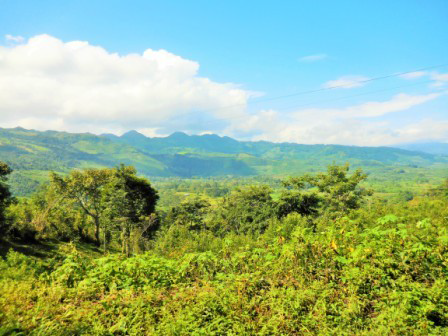
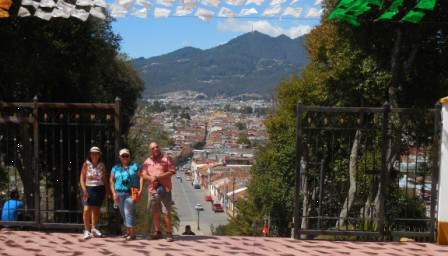
The city, specially the historic center, continues to maintain its Spanish colonial layout, with narrow cobblestone streets, roofs covered in red clay tile and wrought iron balconies with flowers. The facades of the buildings vary from Baroque to neoclassical and Moorish, painted in various colors. Milk delivery from local dairy farms still use canisters on donkeys, and farmer’s typically still use horses and donkeys for hauling wood and farmed goods within their own properties. The city subdivides into three sections but the majority of the population lives in the central section near the city center. Many of the surrounding hills have lost their native trees, in part due to cutting fire-wood and logging operations which feed the local manufacturing and construction industries.
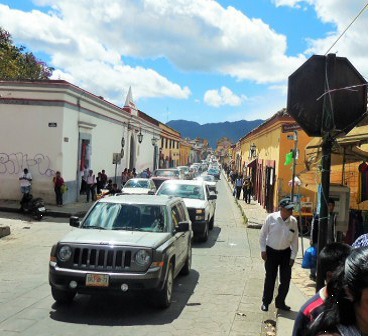
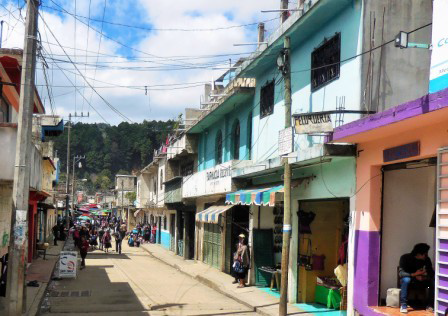
Although the political capital of Chiapas was moved to Tuxtla at the end of the 19th century, San Cristóbal is considered to be the “cultural capital” of the state. Designated a “Pueblo Mágico” (Magical Village) in 2003, it was further recognized as “The most magical of the Pueblos Mágicos” by President Felipe Calderón in 2010. Much of this culture is associated with the cities’ and municipalities’ large indigenous population, which is mostly made up of Tzotzils and Tzeltals. One aspect of traditional culture associated with these indigenous groups is the making of textiles, with amber another important product. Ceramics, wrought iron and filigree jewelry can be found as well. The best known area for crafts is the tianguis at Santo Domingo. The city hosts an annual Amber Expo at the Centro de Convenciones Casa de Mazariegos. The event exhibits and sell amber and amber pieces from the state. A more traditional Mexican market is located just north of the Santo Tomas Church. It is open each day except Sunday, when its vendors go to the surrounding communities in the municipality to sell at their markets. On the days that it is open, the large building, which mostly houses traditional butcher shops, is surrounded by stalls that crowd the nearby streets. There are very few tourists here, except for the occasional backpacker. Markets like this serve traditional dishes such as saffron tamales, sopa de pan, asado coleto, atole de granillo and a drink called posh made from sugar cane.
The city’s attraction for tourists has also led to a number making San Cristóbal their permanent home, which has had an effect of the local culture, especially in the historic center. Many foreign residents have opened up restaurants with Italian, French, Thai, Indian, Chinese and more options, such as vege-tarian available. An older foreign influence is the city’s noted cured meat tradition, which can be traced back to both the Spanish and the Germans. These are featured in a number of dishes including chalupas. Foreign influence can also be seen in the city’s nightlife which offers reggae, salsa, techno and more.
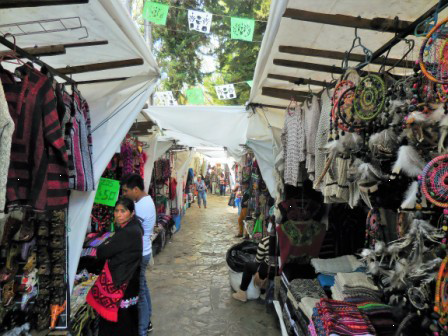
We can attest to the fact that fireworks are common as there are many religious festivals which use them. Important celebrations include those dedicated to the Dulce Niño de Jesús, the Señor de Esquipulas, Saint Anthony, Corpus Christi, San Cristóbal and the Holy Family. This is in addition to the various neighborhood saint celebrations in their respective churches around town. However, the most elaborate rituals are per-formed during Holy Week. Holy Week processions include both silent and chanting marchers. A number are dressed in pointed hoods and carry a heavy platform with religious figures. They go from home to home, stopping at those homes that have erected small shrines. There they say prayers and bless the house and its occupants before moving on. They finally come to rest in a gigantic open house where an inner shrine has been erected, lit by thousands of candles and have a large pot-luck supper. All, even passersby, are welcome to partake. Passion plays depicting the crucifixion of Jesus are common events, with one large one centered in the open plaza behind the municipal palace. After dark, there is the Burning of Judas. These Judas figures are plentiful and include government bureaucrats, Church officials, the army, the United States, Spanish conquistadors, celebrities as well as Judas. The figures are lit by local firemen who try to keep people back at a safe distance, but fireworks fall among the crowds anyway.
The Feria de la Primavera y la Paz (Spring and Peace Fair) run concurrent with Holy Week, especially on Holy Saturday, with music and costumes. It terminates with the burning of Judas. A queen is elected to be crowned the next day. Bullfights are held.
The Festival Cervantino Barroco is held each year in the historic center, featuring invited artists from various parts of Mexico and abroad. It is held in various forums in the city and includes concerts, plays, exhibitions and conferences.
Historic Sites
The main town square is a marked copy of La Florida (park) of Álava, Spain, due to local euphoria with the last name “Ortés De Velasco”. The center of the city is its main plaza. This plaza’s official name is Plaza 31 de marzo, but it is more of-ten simply called the Zócalo. In the colonial era, the city’s main market was here, as well as was the main water supply. Today, it is centered on a kiosk which was added in the early 20th century. The corners of this structure have inscriptions marking the major events of San Cristóbal’s history. The rest of the plaza is filled with gardens and surrounded by the most im-portant buildings and finest homes from the history of the city. Surrounding this plaza are the city’s most important buildings such as the Cathedral and the city hall.
The Cathedral is to the north of the main plaza and it is the most emblematic symbol of the city. However, the main facade does not face the Zócalo, rather it faces its own atrium which is called the Cathedral Plaza. The Cathedral began as a modest church dedicated to the Virgin of the Assumption built in 1528. When Chiapas became a diocese in the 17th century, with San Cristóbal as its seat, this church was torn down to build the current structure, dedicated to Saint Christopher, the patron of the city. The overall structure contains European Baroque, Moorish and indigenous influences. The main facade was finished in 1721 and some final touches were added in the 20th century. The main feature of the church is its main facade, which was finished in 1721. It is Baroque, painted yellow, with ornamental columns and niches in which are various saints. It is divided into three horizontal and three vertical levels marked off by pairs of Solomonic columns and meant to resemble an altarpiece. It is further decorated with intricate raised stucco work, mostly in white, which show Oaxacan and Guatemalan influences. The layout of the interior shows Moorish influence. The main altar is dedicated to both the Virgin of the Assumption and Saint Christopher. The wood pulpit is from the 16th century and gilded. The side walls have two Baroque altar-pieces, one to the Virgin of the Assumption and the other to John of Nepomuk. There is also a small chapel dedicated to the Virgin of Guadalupe on the north side. The sacristy has a large colonial era painting of Jesus in Gethsemane by Juan Correa, as well as paintings by Miguel Cabrera and Eusebio de Aguilar. It is common to see older indigenous women in the Cathedral, with some even traversing the entire nave on their knees to approach the large image of Jesus handing above the Baroque altar.
At the back of the Cathedral, there is an affixed church called the San Nicolás Temple. It was constructed between 1613 and 1621, in Moorish design, by Augustinian monks, for use by the indigenous population. It is the only church in the city which has not been significantly altered since its construction. The roof is pitched and pyramid shaped, built with wood and tile, and its facade is made of stone and brick with little ornamentation. Two of its images, the Señor de la Misericordia and the Virgen de los Dolores, are both from Guatemala.
The city hall, often called the Palacio de Gobierno, is a neoclassical construction which was built in the 19th century by architect Carlos Z. Flores. It contains a series of arches sup-ported by Tuscan columns. In front of the city hall at night, young men and women promenade past each other in oppo-site directions around the gazebo. The city hall is scene to fairly frequent protests, some directly associated with the Zapatistas and others are held by student activists from UNAM in Mexico City. These protests are generally accompanied by lines of riot police.
When Dominicans came to San Cristóbal from Seville, Spain, they were given an area of land to construct their church and monastery. The first stone was laid in 1547 by Francisco Marroqui, then Bishop of Guatemala. The monastery was finished in 1551. It is one of the most ornate structures in Latin America, both due to the stucco work on the main facade and the gilded altarpieces which completely cover the length on the church’s interior. The facade of the main church is Baroque with Salomonic columns, heavily decorated in stucco forms to mimic an altarpiece. The interior has a pulpit carved of wood and covered in gold leaf. The walls are covered in Baroque altarpieces including those dedicated to the Holy Trinity. The La Caridad Temple was constructed on the site in 1712, established as part of the first hospital for the indigenous. The main facade of this church is designed as an altarpiece with two levels, a central bell tower and Tuscan columns and pilasters. Its design is derived from the Baroque that developed in Lima, Peru. There is an image of the Virgen de la Caridad (Virgin of Charity) carrying a baton like a military general. There is also a notable sculpture of Saint James on horseback. The complex contains two museums. The Museo de la Historia de la Ciudad covers the history of the city until the 19th century. Of this collection, the two most impor-tant pieces are some petals of a pomegranate flower, from a receptacle for the Host in the Cathedral. It is one of most im-portant works of Chiapas silver smithing. The rest of the piece has been lost. The other is a part of the original choir seating of the same Cathedral. The Centro Cultural de los Altos has a collection of some of the area’s textiles from each ethnicity and exhibits on how they are made. It has a store associated with it called the Sna Jolobil, which means house of weaving in Tzotzil.
Casa Na Bolom (House of the Jaguar) is a museum, hotel and restaurant located outside the city’s historic center. The structure was built as part of a seminary in 1891, but it became the home of Frans Blom and Gertrude Duby Blom in the 20th century. Franz was an explorer and archeologist and Gertrude was a journalist and photographer. The couple spent over fifty years in Chiapas collecting tools, crafts, archeological pieces and clothing, especially related to the Lacandón Jungle and people. The museum is dedicated to this collection along with keeping some of the old household rooms intact, such as Franz’s study. It also contains a library with more than 10,000 volumes dedicated to the history, culture and anthropology of the region. There are magazine and sound libraries as well as the old chapel which contains colonial-era religious art. The back of the structure contains a botanical garden.
The La Merced monastery was the first in the city founded by the Mercedarians from Guatemala in 1537. It was built as a fortress with barracks for soldiers and space for citizens in case of attack. The church entrance has a massive wooden door with wrought iron hinges and fastenings. There are very few windows and those that exist are built to allow muskets to fire on attackers. The entire structure is built with extensions and abutments to provide for interlocking fields of fire. Entry to the fortifications is denied as too dangerous. The church still functions as such. It consists of a single name, with interior remodeled in neoclassical design during the Porfirio Díaz era. The oldest part of the structure is an arch and columns located in the interior of the sacristy, which is decorated in stucco of various colors with floral and vegetative motifs. At the foot of the column, there are two lions to symbolize Spanish domination. In the latter half of the 19th century, it was used as a military barracks and, in 1960, it was converted into the city jail which it remained until 1993. In 2000, this monastery was converted into the Museum of Amber. It has a collection of over three hundred pieces and is the only one of its kind in the Americas.
The Carmen Temple and the Arco Torre, both in Moorish style, are located on Andador Eclesiastico. The Carmen Temple is all that remains of the former La Encarnación convent which was founded in 1597 with the first nuns arriving between 1609 and 1610. The complex includes the old cloister, nuns’ cells and other structures. The original church building burned and it was restored, conserving its simple facade. One unusual feature of the church is that its layout is “L” shaped, covering the south and west sides of a small plaza. Inside, the walls have carved wood panels and a neoclassical altar which has been recently restored. In the colonial period, the convent and church served as one of the main entrances into the city. An arch with tower was constructed next to the convent in 1680, now simply called the Arco del Carmen. This arch is in pure Moorish style, with three levels of decoration. It is the only one of its style in Mexico. This arch, with its accompanying tower, has been adopted as one of the symbols of San Cristóbal.
The San Cristóbal Church is atop a long staircase up the hill. It is often closed but it offers panoramic views of the city. At the San Cristóbal church, the patron saint is celebrated on July 25 with marimbas, food and fireworks. For ten days previously, each of the main neighborhoods has a pilgrimage to the top of the hill.
The San Francisco Church was built by the Franciscans in 1577 as a monastery but only the church survives. The cur-rent church was built in the 18th century with a single nave covered in a wood and tile roof. The main facade has three levels and two side towers. Inside, it has six Baroque altarpieces. The upper part of the nave has fourteen oil paintings. The atrium has a sculpted stone baptismal font.
The Guadalupe Church is located on the Cerro de Guadalupe. It was constructed in 1834. To reach it, there are seventy nine stairs up the hill. The church has a single nave with a side chapel. The main altar has an oil painting of the Virgin of Guadalupe and the side chapel contains a sculpture of the virgin from 1850. The atrium affords panoramic views of the city. The feast of this Virgin is celebrated annually with a parade on the main street with fireworks, rockets and candlelight vigils.
The Santo Tomás Church is just north of the historic center. It has a museum in the back, in a building which was the bar-racks and parade grounds built when the city was founded.
The Santa Lucía Church was constructed in 1884 by architect Carlos Z. Flores over what was a dilapidated chapel. It con-sists of a single nave with pilasters on its walls and pointed arches. The main altar is Gothic with Neoclassical and Art Nouveau elements.
The Museo Mesoamericano del Jade has jade pieces from the Olmec, Teotihuacan, Mixtec, Zapotec, Maya, Toltec and Aztec cultures. There is also a life-sized replica of the burial chamber of Pakal of Palenque as it looked when the king was buried. The Maya Medicine Museum is dedicated to the various techniques and practices of indigenous medicine, many of which are still practiced today. The Museo de las Culturas Populares de Chiapas (Museum of Popular Cultures of Chiapas) is located on Diego de Mazariego Street. It is mostly dedicated to the indigenous cultures of the state with the aim of recuper-ating, valuing and promoting knowledge of these cultures in Chiapas and beyond. The museum has exhibits of many of these cultures and also sponsored live events related to its mission as well.
Casa de las Sirenas is one of the most notable domestic structures from the colonial era. It was built in Plateresque style and dates from the 16th century by Andrés de la Tovilla. It is named after a mermaid that appears on its crest on one of the corners.
The Antiguo Colegio de San Francisco Javier today houses the Faculty of Law of the state university. It was originally founded by the Jesuits in 1681 for the education of the Spanish elite. Its current facade is two levels in neoclassical style. The interior contains murals about the Spanish conquest of Mexico.
History
The city was founded as Villa Real de Chiapa in 1528 by Diego de Mazariegos in what was called the Hueyzacatlán Valley, which means “pasture” in Nahuatl. From then on, the city went through a number of name changes: to Villa Viciosa in 1529, to Villa de San Cristóbal de los Llanos in 1531, and to Ciudad Real in 1536. It was changed to Ciudad de San Cristóbal in 1829. “de las Casas” was added in 1848 in honor of Bar-tolomé de las Casas. There were some modifications in the early 20th century to the name but it returned to San Cristóbal de las Casas in 1943. In the Tzotzil and Tzeltal languages, the name of the area is Jovel, the place in the clouds.
The area did not have a pre Hispanic city. After defeating the Zoques in the Northern Mountains and the Chiapans of this area, Diego de Mazariegos founded the city as a military fort. This city, and much of what would be the state of Chiapas came under the Captaincy General of Guatemala in 1532 headed by Pedro de Alvarado. San Cristóbal received its coat of arms in 1535 from Carlos V and it was officially declared a city in 1536. The city gained the rank of Alcadía Mayor in 1577 which gave it authority over much of Chiapas north of it. The intendencia of Chiapas was created in 1786 combining San Cristóbal’s territory with that of Tuxtla and Soconusco, with the government in San Cristóbal. In 1821, the city followed Comitán de Domínguez’ declaration of independence from Spain and the Captaincy General of Guatemala. However, the city and the rest of Chiapas would become a part of Mexico in 1824, with the capital established here.
In 1829, the name Ciudad Real was changed to San Cristóbal. In the 19th century, the state government would shift back and forth between San Cristóbal, in the highlands domi-nated by Conservatives and Tuxtla, which favored the Liberals. Independent tendencies arose again in 1853, when the Plan of Yalmús was announced declaring the then Mexican Constitution null. Conservative forces attacked the city in 1857 but were dis-lodged shortly thereafter by Liberal Angel Albino Corzo. The last of French forces were expelled from the city in 1864. The state government was moved from San Cristóbal to Tuxtla for good in 1892 by the Liberal government. There was a failed at-tempt in 1911 by Conservatives in San Cristóbal and neighbor-ing San Juan Chamula to force the capital to return.
In 1915, the state went to the municipality system with San Cristóbal becoming a municipality. Originally, it had jurisdiction over communities such as San Lucas, Zinacantán, San Felipe Ecatepec, Tenejapa, San Miguel Mitontic, Huixtan and Chanal, but these would later separate to become municipali-ties in their own right. In the 20th century, the outskirts of the city become filled with open pit mines for gravel and sand. There was even one opened on a hill in the San Diego and La Florecilla neighborhoods, near the historic center called Salsipuedes. These prompted environmental and local community organizations to protest, stating that the valley is a closed water basin and the mining negatively affects potable water sup-plies. Salsipuedes was closed in the 2000s. The city was declared a national historic monument in 1974.
History of Political Activism
San Cristóbal became the center of political activism with the election of Samuel Ruiz as bishop of Chiapas in 1960. In the 1960s and 1970s, the traditional Catholic Church was losing indigenous adherents to Protestant and other Christian groups. To counter this, Ruiz supported and worked with Marxist priests and nuns following an ideology called liberation theology. In 1974, he organized a state wide “Indian Congress” with representatives from the Tzeltal, Tzotzil, Tojolabal and Ch’ol peoples from 327 communities as well as Marxists and the Maoist People’s Union. 1990s. During this decade, the Mexican federal government adopted neoliberalism, which clashed with the leftist political ideas of liberation theology and many of the indigenous activist groups. Despite the activism, economic marginalization among indigenous groups remained high, and resentment was strong-est in the San Cristóbal region, along with migrants living in the Lacandon Jungle. These grievances would be taken up by a small guerrilla band led by a man called only “Subcomandante Marcos.”
This small band, called the Zapatista Army of National Liberation (Ejército Zapatista de Liberación Nacional, EZLN), came to the world’s attention when on January 1, 1994, the day the NAFTA treaty went into effect. On this day, EZLN forces occupied and took over the towns of San Cristóbal de las Casas, along with six other Chiapas communities. They read their proclamation of revolt to the world and then laid siege to a nearby military base, capturing weapons and releasing many prisoners from the jails. Ruiz negotiated between the EZLN and authorities even though his leftist activism made him suspect to many authorities. This would undermine efforts and eventually the Catholic Church would split from the Zapatista movement. However, the negotiations would lead to the San Andrés Ac-cords and ended the rebellion peacefully. By the time he died in 2011, he was locally given the name of “Tatic” which means “father” in Tzotzil, and received numerous distinctions including the Simon Bolivar Prize from UNESCO and the International Human Rights Award in Nuremberg.Since the Zapatista uprising in 1994, the city has developed a type of cult tourism focusing around the EZLN. This tourism at-tracts those interested in both leftist political beliefs and indigenous activism that come to see where the events of the 1990s happened, as well as what is going on now. This tourism has spurred the creation of Zapatista-themed shops which sell EZLN shirts and other souvenirs. This tourism has been given the name of “Zapaturismo” or “Zapatourism.” The term originally was derogatory and referred to the large number of leftist activists that converged on the city after the EZLN uprising began. Since then, the term receives mixed reviews with some finding humor in it.
Demographics
Indigenous Mayan languages are spoken by about half of the city’s population. As of 2010, the municipality had a total population of 185,917. As of 2010, the city of San Cristóbal de las Casas had a population of 158,027. Other than the city of San Cristóbal de las Casas, the municipality had 110 localities, the largest of which (with 2010 populations in parentheses) were: San Antonio del Monte (2,196), La Candelaria (1,955), Mitzitón (1,293), and San José Yashitinín (1,109), classified as rural. As of 2010, 59,943 people in the municipality spoke an indigenous language. The two most important ethnic groups in the area are the Tzotzil and Tzetzal. About 85% of the municipal population lives in the city proper with the rest in rural communities. Most of the population is young, with about 68% under the age of thirty and an average age of twenty. The population is expected to double within twenty years.
Submitted by Dan and Lisa Goy
Owners of Baja Amigos RV Caravan Tours
Experiences from our 90-day Mexico RV Tour: January 7-April 5, 2016
www.BajaAmigos.net
you can reach Dan and Lisa Goy at thegoys@manzanillosun.com
Download the full edition or view it online
Dan and Lisa Goy, owners of Baja Amigos RV Caravan Tours, have been making Mexico their second home for more than 30 years and love to introduce Mexico to newcomers.



